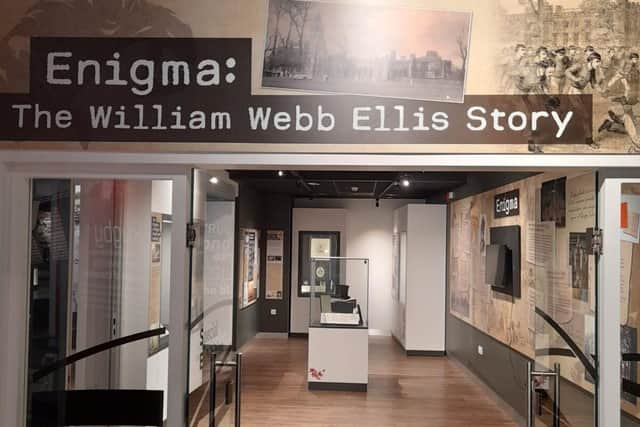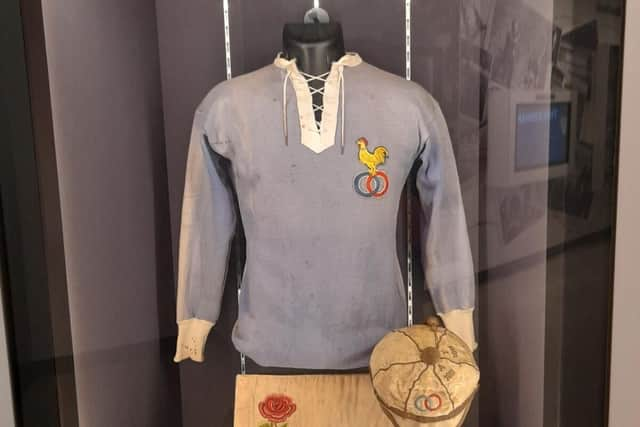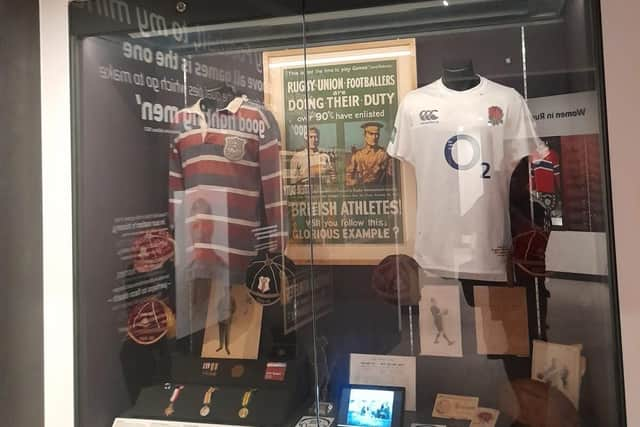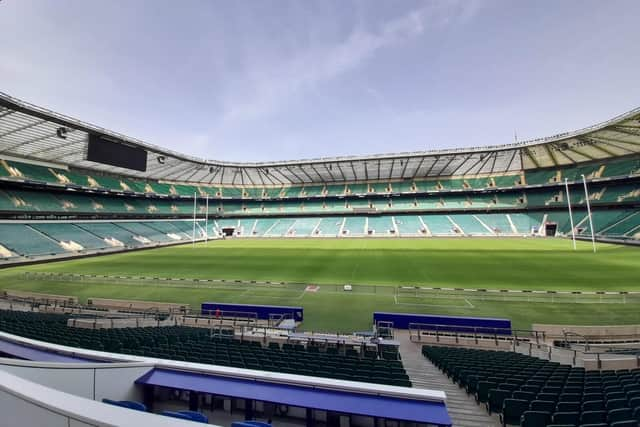Exploring Rugby's sporting history: From the birthplace of rugby to the home of the game
and live on Freeview channel 276
Call it fate or the gods of rugby looking down on me, maybe it was even a calling. No sooner had plans been made and booked for my recent visit and guided tour of Rugby School, the birthplace of rugby football, and exploring the Webb Ellis Rugby Football Museum than I receive an invitation. A special one too. To visit Twickenham, the home of England Rugby.
More specifically to attend the launch of a new exhibition about the infamous pioneering figure of rugby football, William Webb Ellis, who it seems still very much divides opinion (depending which side of the try-line you stand) to whether his actions are legendary or just a myth. It just seemed a little coincidental and was certainly not in the planning.
Advertisement
Hide AdAdvertisement
Hide AdOne afternoon I am standing on the hallowed turf where the world’s most famous schoolboy who created the worldwide sport of rugby did his pioneering act; a few days later I would be casting my eye over an exhibition at the World Rugby Museum about the very same man, very aptly titled Enigma: The William Webb Ellis Story. But there was more to emerge from this visit than I had bargained for, and all not necessarily regarding the main subject matter; but for another famous rugby name who like Webb Ellis graced the hallowed turf of The Close and the birthplace of the game and is now also forever remembered on the turf of the home of rugby in south-west London.


Over the years I have had the pleasure of visiting many great sporting stadiums at home and overseas and witnessed some great sporting moments to boot. For one reason or another though I had never made it to Twickenham. It’s not for the want of trying I might add. This is until now.
It has always been on my list of ‘places to visit’ either to watch a match or as in this case, go behind the scenes on a non-match day as part of a stadium tour and also get a look inside at the World Rugby Museum. Someone from Rugby with an interest in rugby and its history, it is only logical you would also want to come here. And it is part of the Stadium Tour experience too.
So having arrived early for the allocated tour slot, it gives me ample time to explore the Museum. And as if by chance, I have the place to myself for a good hour or more to really absorb everything that is here. And believe me when I say there is a lot to see.
Advertisement
Hide AdAdvertisement
Hide AdIt is a proverbial treasure trove and the most extensive collection of rugby football memorabilia from the world of rugby past and present. The numbers in the collection speak for themselves really: there are over 41,000 recorded objects, 16,500 pieces of archival material and over 11,000 photographs. The archive material here dates from the mid-nineteenth century to the present day and spans the history of rugby right from its origins through to the present day. And Rugby and Rugby School can take a bit of credit for some of its most important items. They include the game's first written laws which, together with the RFU's minutes, date from 1871. Where photography is concerned, it holds the first known photograph of the sport 'A Bigside at Rugby' which dates from 1860, with further nods to the game’s birthplace with a Pierre De Coubertin-era French jersey and some early examples of caps again originating from Rugby School.


However, of all the numerous exhibits and quite fascinating material, interactive screens and even some hands-on games and challenges (some of which are quite testing), one exhibition area in particular really caught my attention. Wartime. It was proper ‘lump in the throat’ material with a poignant display of memorabilia and video reels and footage from World War I, including honourable mentions to the Reverend Rupert Edward Inglis and Ronald William Poulton Palmer, both former pupils at Rugby School, the latter of which the full enormity would become further apparent as the day progressed.
So having down one circuit of the Museum prior to the stadium tour (but making a mental note to come back later for another look – you always miss something don’t you, but get it on the way back!), two things struck me. One, just how vast the Museum and its collection is, and two it made me wonder what Rugby the town has missed out on. It really has missed a trick.
Yes, there is Rugby School and its lovely museum. And there is also the equally excellent Webb Ellis Rugby Football Museum (which you have hopefully read about too). You may also recall that Rugby was for a short four-year period between November 2016 and November 2020 the home for the World Rugby Hall of Fame. It is a shame that it was only short-lived and in my opinion a hugely wasted lost opportunity to showcase rugby in its birthplace and bring further prominence to Rugby the town as a tourist destination in the way that Shakespeare does to Stratford-upon-Avon.
Advertisement
Hide AdAdvertisement
Hide AdThere is of course more to Rugby than just rugby, but for the town which it gives name to the birthplace to not have a permanent collective venue celebrating everything about the worldwide sport, it is nothing sort of a travesty.


But that’s another story and argument for another time...
So having navigated my way around the Museum, it’s time for the Stadium Tour, the chance to really see behind the scenes and visit exclusive areas of Twickenham. It begins with the Rose and Poppy Gates, before visiting the hospitality suites including the Royal Dining Suite before taking a seat in the Royal Box and getting a view that members of the Royal Family and other VIPs would get on match day.
To get here we pass some quite elegant pieces of artwork, one of which in particular hung on a wall inside the West Stand stood out. Simply titled 'Forever England', this painting by artist Shane Record is based on a photograph of the England 1914 Grand Slam winning side in Paris on the eve of their final game of the season. It would be their last game of rugby together before the First World War broke out with five players from that England team sadly paying the ultimate sacrifice with their lives.
From the Royal Box in it’s down pitch side, although not quite on the hallowed turf itself but literally to the edge and the touchline. And it’s here the enormity of what is the biggest rugby playing stadium in the world from ground level really hits you. It is immense, and that’s when it is empty. Imagine what it must feel like for a player with over 80,000 rugby fans inside and watching your every move.
Advertisement
Hide AdAdvertisement
Hide Ad

Before we exit the pitch and head down the Player’s Tunnel, we are drawn by our guide to a patch of turf with a white background, a red rose and beneath it the words Ronnie Poulton 1889-1915.
Ronald William Poulton was a pupil at Rugby School and I recall was spoken about on my aforementioned tour of Rugby School with his name etched into the walls of the Memorial Chapel. Whilst serving his education here, we was a member of the School’s 1st XI at cricket, but especially excelled in the rugby 1st XV at the spiritual home of the game being a member of the team for three seasons and captain in 1907, even playing alongside Rupert Brooke, another of Rugby’s ‘sons’ who would later become well-known as a war poet.
Considered by many as perhaps the greatest-ever attacking rugby union three-quarter and the best player of his day Poulton played 17 times for England, including against Wales in the first international at Twickenham in 1910 and was captain of the 1914 Grand Slam winning team. The last international rugby match to be held before the First World War was that 1914 fixture between England and France, at Colombes on 13 April 1914. It was during England's 39–13 victory, he set a record for scoring the highest number of tries (four) in an international match which remained until 2011.
In the spring of 1915, he was at the front in Flanders, where he was to play his final game of rugby, captaining South Midland division. It was whilst supervising engineering works in a trench just north of Ploegsteert Wood in Belgium he was shot by a sniper on 5th May. Lieutenant Ronald William Poulton is buried in the Royal Berks Cemetery, Hyde Park Corner, in Belgium and would receive a posthumous Victoria Cross for bravery. He was inducted into the World Rugby Hall of Fame on 20 September 2015. His last words were reputed to be: “I shall never play at Twickenham again.”
Advertisement
Hide AdAdvertisement
Hide AdHowever a piece of hallowed ground from the home of England Rugby will forever mark his grave while a piece of the country he died defending lies at Twickenham Ahead of the annual Army v Navy match at Twickenham in 2018, which fell on the 103rd anniversary of Poulton’s death, soil taken from around his headstone was buried beside the pitch, over which players run out for every match. The soil was buried by former England player and the Rugby Football Union’s (RFU) Great War Ambassador Lewis Moody.
The week previous Moody had visited Poulton’s grave in Belgium, where he placed soil from the Twickenham pitch whose ground staff had kept soil from the stadium pitch to take to Ronnie’s grave and, with the help of the Commonwealth War Graves Commission, this was scattered there.


Talk about lump in the throat moments, and as fitting tributes go, this really is quite something.
Bringing us back to the modern day, it’s back under the stadium and a visit to the England Changing Room to see and learn about the match day preparations and routines of the players who ply their trade here. Physio tables, ice baths, bath tubs and all.
Advertisement
Hide AdAdvertisement
Hide AdIt brings us full circle back to the Rose and Poppy Gates to conclude what is a quite fascinating and engaging tour, and one I would highly recommend.
So to one of the primary reason for visiting? The special pre-launch of the exhibition - Enigma: The William Webb Ellis Story.
Curator Phil McGowan told me they had been looking to do a dedicated focus and exhibition on Webb Ellis at the World Rugby Museum for some time and finally after intensive planning and research and to coincide with his famous act 200 years it was quite apt it all came together now.
The myth and legacy of WWE has always divided opinion and still does – just see my Twitter account to my recent article on the Rugby School Tour – and the whole purpose of the exhibition is to highlight his legacy asking who was Webb Ellis, did he really invent the game and what did he do next?
Advertisement
Hide AdAdvertisement
Hide AdIt does just that examining in great detail about his life before, during and after his time at Rugby School, as well as displaying some of his personal effects including a sliver snuffbox.
There is information about the origins of the game and quite timely details about the 1923 Centenary Celebrations at Rugby School, along with some very interesting artefacts on loan from the School, notably what is believed to a top hat of Mathew Bloxam, the Rugby School old boy and benefactor who named Webb Ellis as the boy first caught the ball and ran with it. What the exhibition does pose though is some interesting thought-provoking questions, particularly from Webb Ellis himself on the back of his own diary notes during his later years as an Anglican clergyman before his death in 1872. All I will say is it is best to visit the exhibition and evidence for yourself and draw your own conclusions to see which side of history and fact or fiction you believe.
Either way, finally making this visit to Twickenham has been an interesting experience, as it has provided chance to inadvertently follow the path and stories of two former pupils of Rugby School who having both graced the hallow turf of The Close in their youth in their own different ways made their own mark on both the birthplace and the home of rugby.
Useful Information
Enigma: The William Webb Ellis Story runs at the World Rugby Museum at Twickenham until March 2024.
Advertisement
Hide AdAdvertisement
Hide AdTickets for the World Rugby Museum and Twickenham Stadium Tours can be booked on their website at https://worldrugbymuseum.com/booking
Karl Quinney is a freelance business copywriter and travel writer based in Rugby, Warwickshire. Despite an interest in the game and its history, he has never played the game!
Visit his websites at www.karlquinney.co.uk and www.thelandlockedtraveller.co.uk